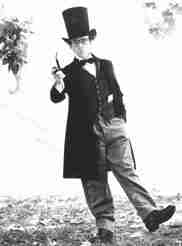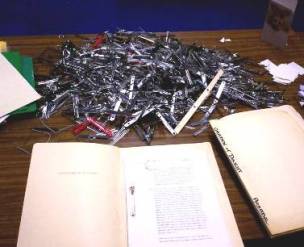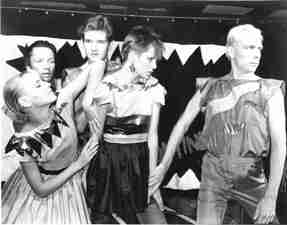This post continues on from “The trials and tribulations of a rookie archivist – Part 1”.
Disposal
An introduction to the archival art of disposal furthered my enthusiasm for completing the project, and amongst the first items to be removed from the collection were two boxes of tickets and stubs and a large pile of receipts and invoices. In accordance with CSU Regional Archives’ normal administrative practice, ephemeral or facilitative records not considered to be of continuing value, as well as certain types of financial records may be disposed of.
The duplication of many documents in the RTC collection required sifting through each folder and contributed to the disposal of 33 boxes throughout this process. Other items disposed of included promotional material from other organisations, magazines, booklets, some very low-level correspondence and several disintegrating plastic sheets.
More experience and familiarity with the Archives’ disposal practice would likely have led to the removal of much more material from this collection; many files had dubious continuing value, but I was not always confident of asserting this.
Preservation
The preservation task of removing all metal objects (pins, paperclips, bulldog clips, binder clips, clasps and staples) from the documents initially seemed daunting, but became manageable as several small mountains of metal were built on the table. After a few days of this activity, I could rest with the knowledge that most of the metal was gone.
Other archival concerns were the many faxed documents on thermal paper and carbon copied coloured pages, both of which have relatively short life spans. Although the RTC had made copies of some faxed documents, there were many that hadn’t been copied and not all of these were reformatted during this project.
Photographs
Saving the photographs to the end of the arrangement process meant I had something to look forward to, as I had glimpsed a lot of funny hairstyles and eighties costumes, and could finally understand what the productions were or would have looked like to their audiences. The RTC records included a few thousand production photographs and images of the company, but knowing which production the photographs were from was not always possible.
Many photos had been stored and displayed in self adhesive albums which had caused them to become “stuck” and the images needed to be carefully removed to prevent damage before being transferred into archival sheets.
Description and Outcome
The process of description involved compiling a list of main categories or “List of Series lists”, which formed a sequence in which smaller series could be incorporated. Several groups of files, such as those relating to the same production, were secured together, and finally numbering each file was a highlight of the process.
Working systematically through the various piles on the shelving saw them disappear back into boxes, with the end result of a lengthy list and many empty boxes to be packed down. The completed listing of or guide to the RTC records contains 43 series and 1476 items, and is now stored in 79 type 1 boxes, 21 photograph albums and one map drawer.
Conclusion
Virtually all my exploration through the RTC records was conducted with little probing into the complexities of the theatre company’s operation, but much study of the strata of successive filing systems and administrative tendencies. It would be interesting to observe records from the later period of the theatre company’s history (1997 – 2009) and bear witness to the progression of electronic files and changing nature of physical documents.
The early years saw record keeping practices that embraced typewriter technology, telegrams, foolscap, vast arrays of scrap and ephemeral note taking, and a multiplicity of now vintage stationary supplies. Although the records from their final twelve years are not currently in the custody of the CSU Regional Archives, it can be assumed that many would reveal a dependence on the electronic creation and maintenance of documents.
Completing this project has greatly enhanced my studies in archives, and I now have a greater understanding about the types of documents and files that exist in the world, just how numerous they can be, and how to keep calm in the face of potential mayhem and disorder.




raymond says:
I am a hoarder, and am NOT an archivist. It saddens me to read this:
“… amongst the first items to be removed from the collection were two boxes of tickets and stubs and a large pile of receipts and invoices. …”
AND THIS:
“… Other items disposed of included promotional material from other organisations, magazines, booklets, …”
Apart from the PERMANENT loss of such materials by ‘destruction’, perhaps your organisation is also missing out on the opportunity to earn some pocket-money by offering to sell these duplicates — be in on e-bay or elsewhere. I feel sure that there would be MANY collectors world-wide who would love to have some of these items in their own collections.
Notwithstanding the above comment, I thank you for sharing your experience with us all.
Debra Leigo says:
Thank you for sharing the second part of Sarah’s experience with us Jillian. Disposal is certainly a daunting task requiring careful analysis; hopefully confidence grows with experience.
Is the finding aid (listing) Sarah produced for RW1780, the Riverina Theatre Company, available online?
I am also interested in your response to Raymond’s comment.
Wayne Doubleday says:
Hi Raymond,
Thanks for your comment.
Disposal of records is, and always has been, a contentious issue which archivists face on a daily basis. Unfortunately it is impossible for archivists to retain every record or item that is deposited or donated to an archival organisation due to storage and space constraints. All archives undertake disposal of records in one form or another, ideally using authorised disposal schedules and/or Normal Administrative Practice (NAP).
In this particular instance the vast majority of material removed from the collection were duplicates and temporary financial records (including tickets, stubs, receipts and invoices) which had only been retained originally by the Riverina Theatre Company (RTC) for audit purposes.
The records from the RTC were deposited into the ‘custody’ of the CSU Regional Archives (not donated), and therefore are not the legal property of the Regional Archives. As a result, it would be highly unethical and unlawful to sell any of the duplicate material which is not owned by the Regional Archives.
Hope this helps to explain how our disposal system works.
Jillian Kohlhagen says:
Hi Debra,
At the moment there is no comprehensive listing of the RTC records online.
We are, however, slowly working on getting our database to a technological point where our item lists can be accessed via the web. So hopefully, some time in the not too distant future, all our finding aids will be online. We’re just not quite there yet!